An aspect of solid state drives that is being explored more recently is the number of form factors into which you can fit them. While mechanical hard disks have a very specific set of dimensions they need to fit into, SSDs have no such problems. The 2.5” SSDs that we get today are really only in that form factor because that’s what our machines have largely standardized to, but as Apple’s recent MacBook Air refresh has proven, you can fit an SSD pretty much anywhere these days. So it is with Viking Modular’s new SATADIMM SSD drive.
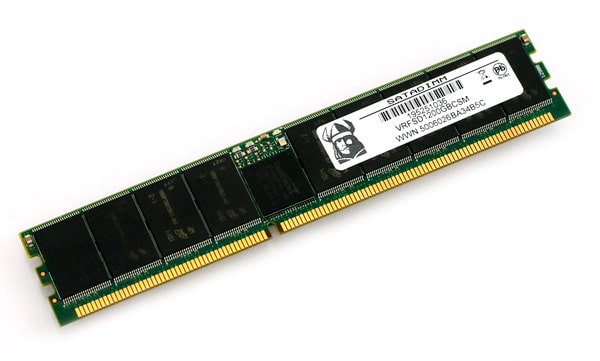
Regular users with a healthy number of drive bays to spare are less likely to see the value of a drive like this, but modders working with MiniITX enclosures and enterprise users looking to add capacity to a blade server are likely going to be much more excited about this new SSD form factor. Simply put, Viking Modular has created an SSD that mounts to a DDR3 slot. Sure, you still need to connect a SATA cable, but besides that you have an SSD that occupies very little space and draws all of its current from the DIMM slot.
That enterprise space is really where the SATADIMM is going to shine. Enterprise motherboards are often loaded to the gills with DIMM slots, but finding space to mount 2.5” hard drives is another matter entirely. By creating an SSD that can fit into and be powered by a DIMM slot, Viking Modular has provided a very useful alternative in adding capacity to a server without sacrificing valuable space.
The SATADIMM utilizes an enterprise-class SandForce SF-1500 series controller (also available with an SF-1200) and is shipping in capacities of 25GB to 200GB for the SLC version, and 50GB to 400GB for the eMLC and MLC drives. Our review model is the VRFSD1200GBCSM, the 200GB MLC iteration of the drive. At this time, the SATADIMM is only available to OEMs and through enterprise sales channels.
Aesthetics

If you didn’t know any better, you’d think the SATADIMM was a regular stick of memory, but that SATA connector at the top should clue you in. Nonetheless, it’s designed to snap into place just like a conventional DDR3 DIMM. The SATADIMM is basically two parts, the main board with the flash, SATA connector, and SandForce controller, and a daughter board that handles power regulation.
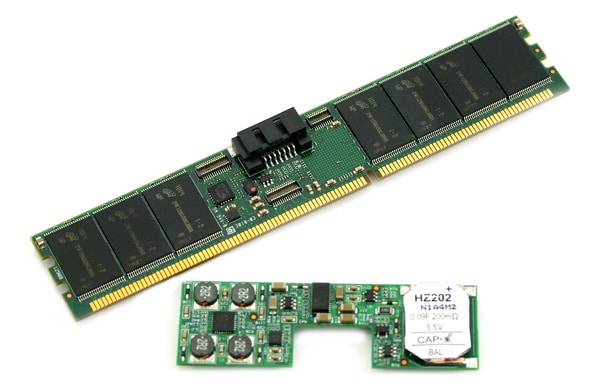
Outside of being slightly thicker than your average DDR3 memory module, the SATADIMM blends in perfectly with other sticks of RAM.
Disassembly
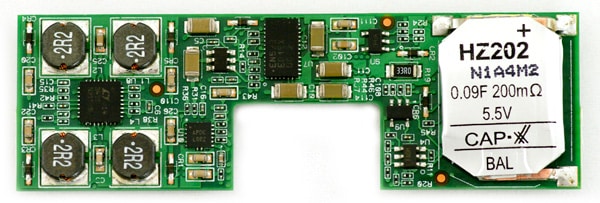
With the SATADIMM there isn’t really anything to disassemble: the cards are all on the table from the get-go, with the flash modules readily visible along with the SATA interface and the SandForce controller chip. The daughter board can be removed, exposing three micro-connectors that feed power into and out of the power regulation daughter board.
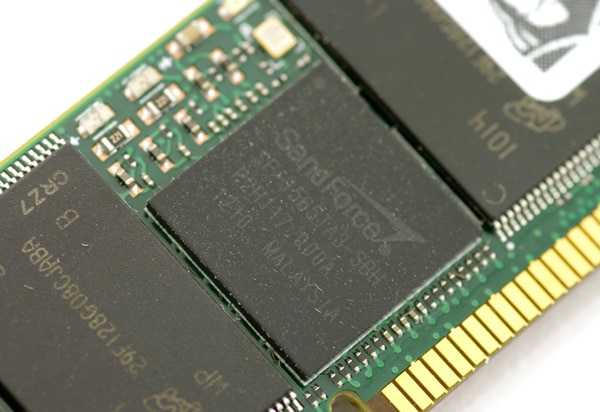
The Viking SATADIMM 200GB drive is powered by a SandForce SF-1565TA3-SBH enterprise controller and it is paired up with sixteen 16GB Micron 29f128g08cjaba flash modules. With how well space is used on this small SSD, I don’t think there is really any wasted volume at all.


Synthetic Benchmarks
It’ll be interesting to see how the SandForce controller on the SATADIMM holds up; unlike standard SandForce-based SSDs the SATADIMM’s specs are comparatively conservative. We employed our usual test bench, a Dell XPS 9000 with drives benchmarked through the 3.0Gbps Intel ICH10R SATA controller, running in AHCI mode with TRIM enabled. We use Microsoft Windows 7 Home Premium 64-bit.
In this review we’re comparing the 200GB SATADIMM with Viking Modular’s 120GB 2.5" enterprise-class SSD, the OWC Mercury Extreme Pro (fastest SF-1200 SSD) and the Intel X25-M.
Our synthetic benchmarks are done using IOMeter and CrystalDiskMark to get a general feel for performance before launching into real world testing. For testing SSDs, we use the standard 512-byte test alongside a 4K test.
We start out with IOMeter’s 2MB sequential transfer test; this test is helpful in seeing how well the drives can hit their advertised transfer speeds.
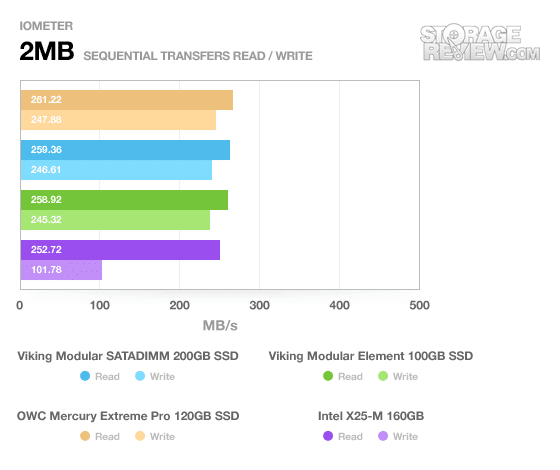
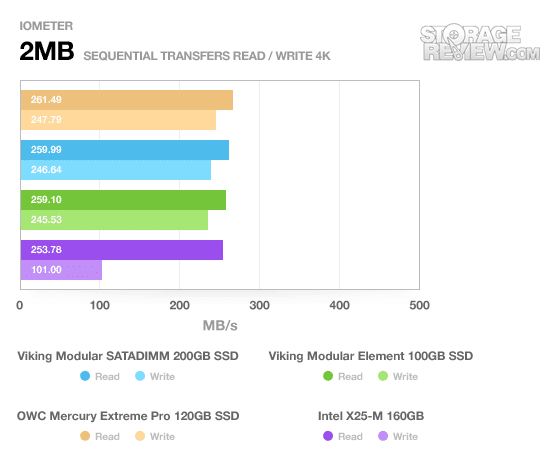
In our sequential transfer tests, the Viking SATADIMM hangs with the SandForce-based OWC Mercury Extreme Pro 120GB and cruises past the Intel drive. The form factor may be different, but it looks like the SandForce performance is still there.
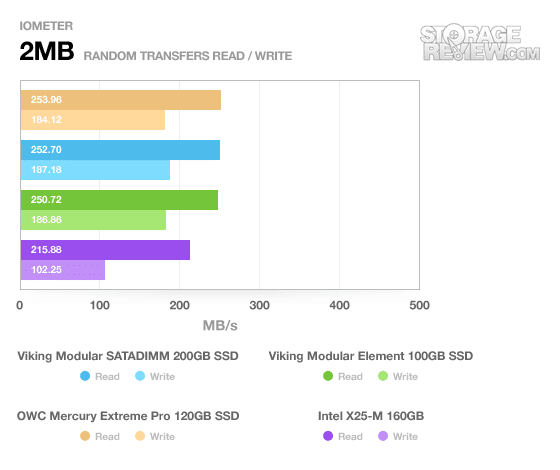
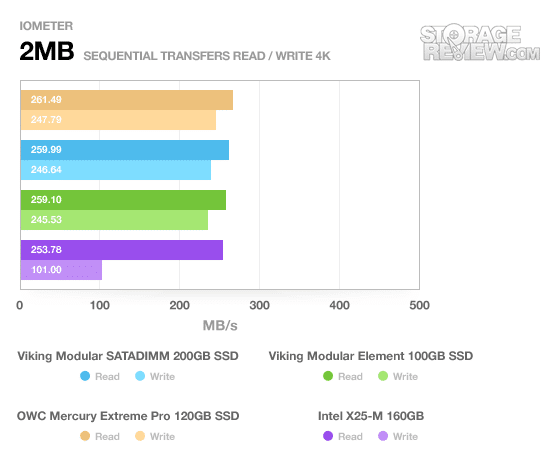
Switching up to a random transfer test still tells the same story. Viking’s SATADIMM hangs tight with OWC’s drive.
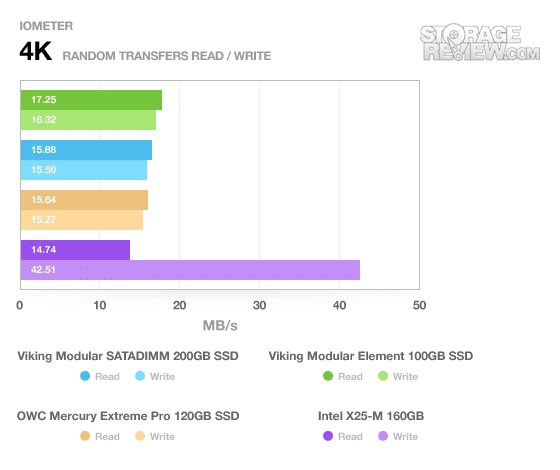
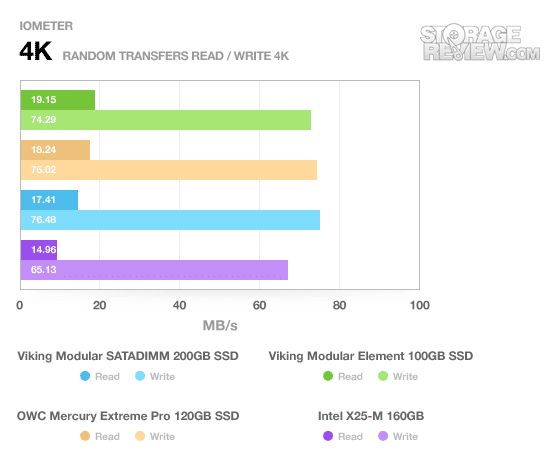
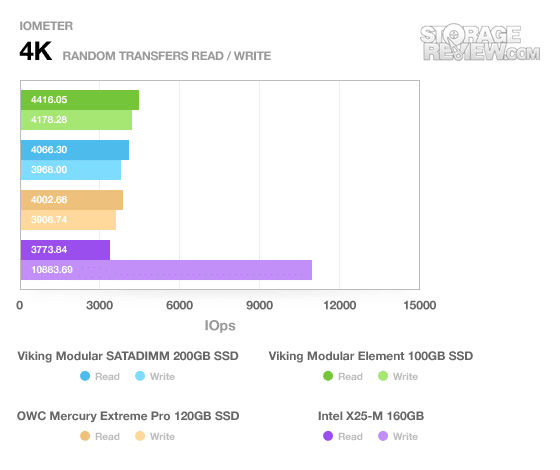
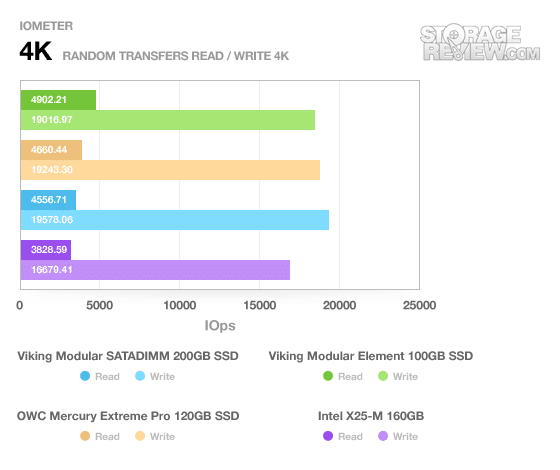
Once again the SATADIMM nips at OWC’s drive’s heels. Form factor notwithstanding, the drives are indistinguishable.
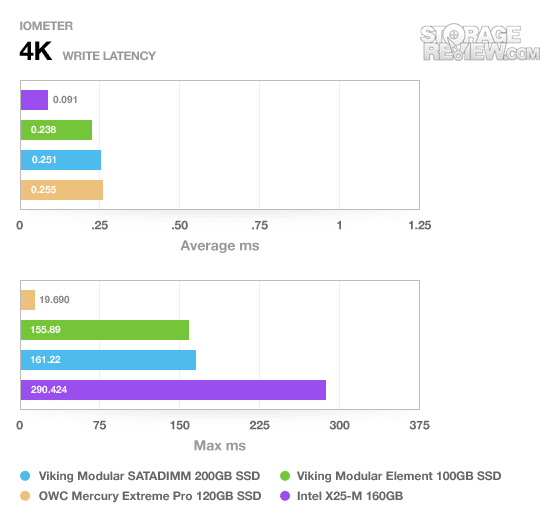
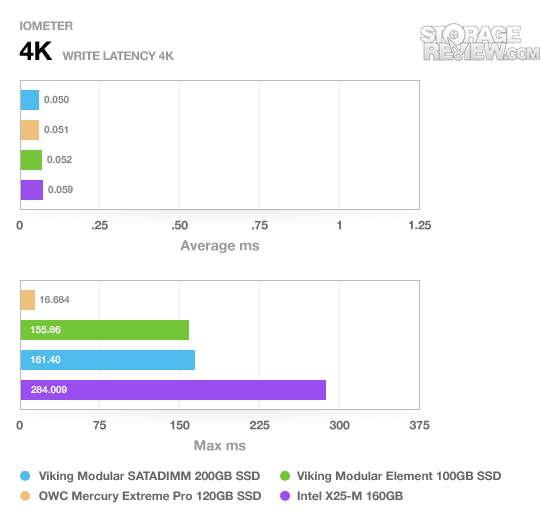
When we get to write latency we see a problem that has only materialized on a couple of odd SandForce drives: the average remains consistent between the two, but Viking’s drive’s peak latency is nearly ten times that of the OWC. It remains to be seen whether or not this will affect the SATADIMM in more real world use, but it’s a red flag nonetheless. Neither is as bad as Intel’s write latency, but this seems to be one case where SandForce implementations can vary fairly wildly.
Next we make a pit stop with CrystalDiskMark to test for peak performance.
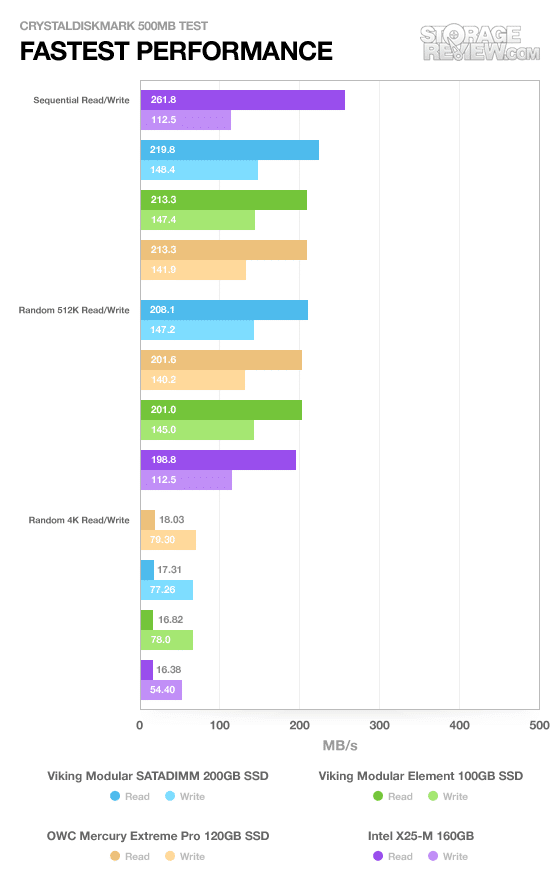
CrystalDiskMark isn’t as kind to the SandForce drives as IOMeter can be, but the SATADIMM and OWC drive nonetheless hang close together again, with the SATADIMM even posting slightly faster numbers.
Shifting back to IOMeter, let’s see how the SATADIMM performs in simulated server workloads to see if that write latency rears its ugly head.
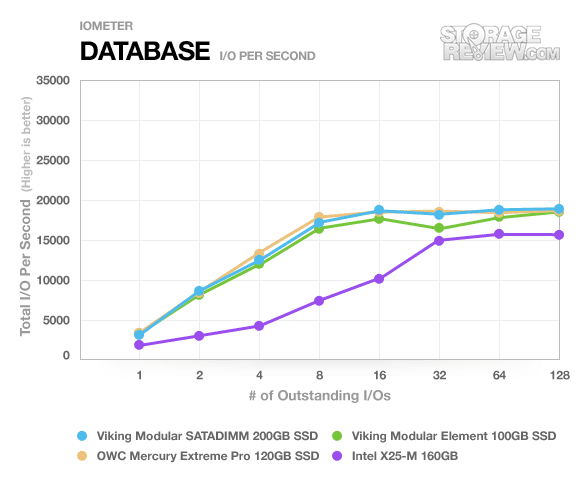
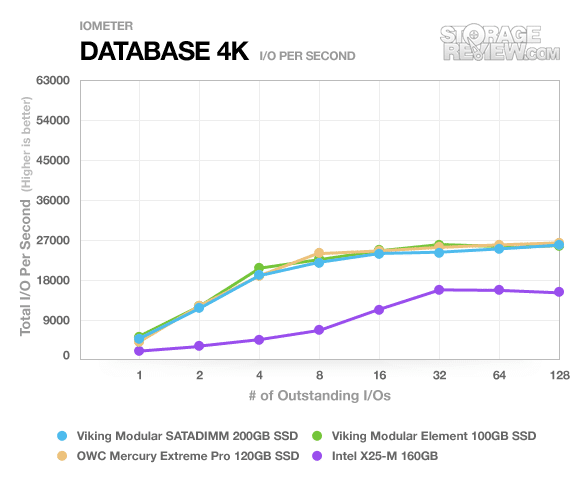
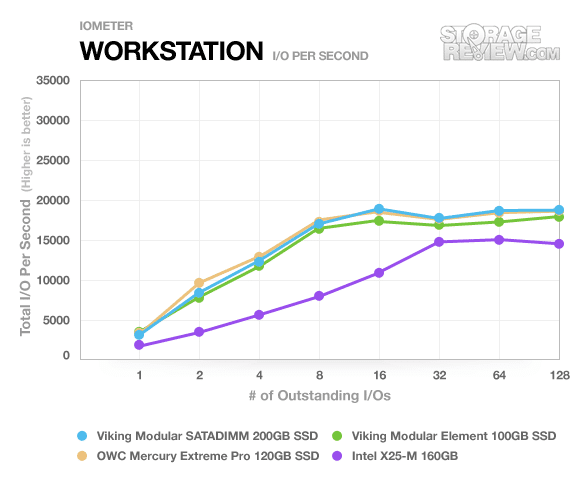
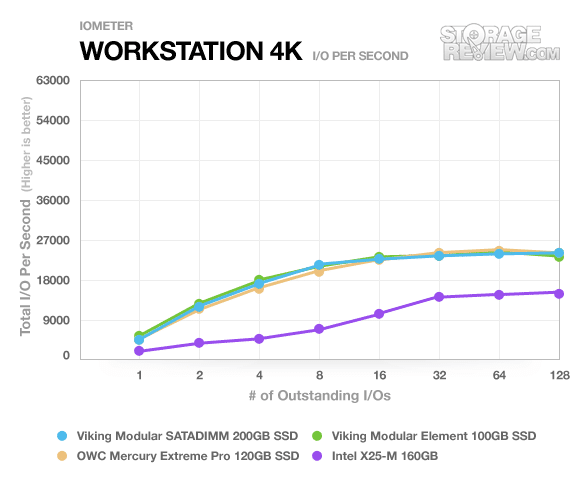
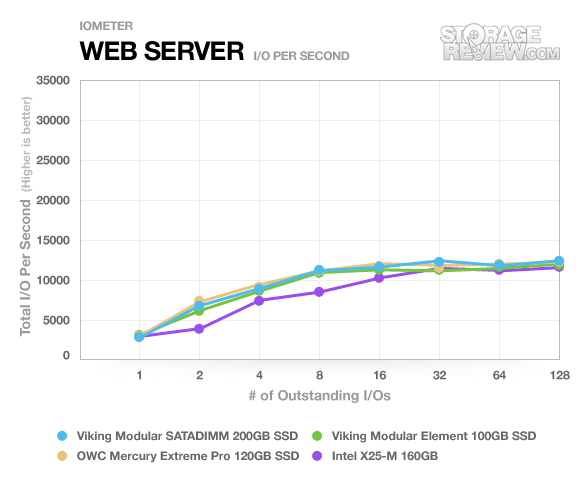
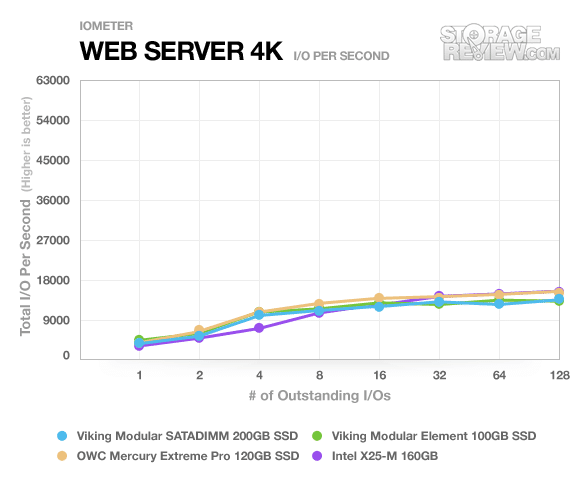
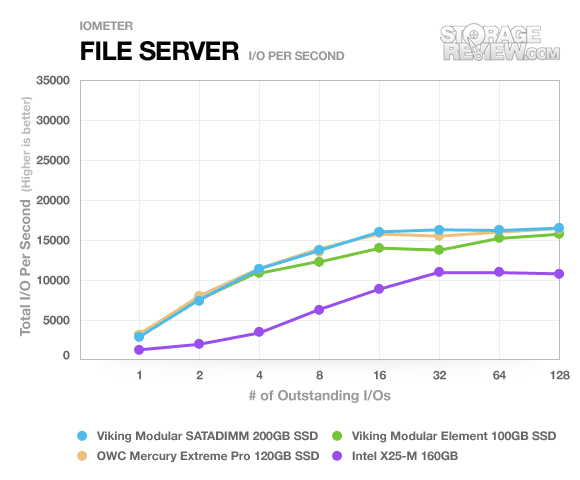
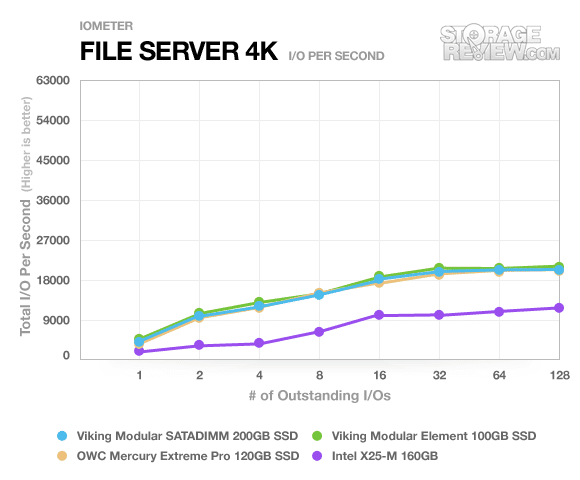
Once again, the SATADIMM curls up right next to the OWC Mercury Extreme Pro. The two trade blows in certain disciplines, but essentially the drives are comparable.
Real-World Benchmarks
The synthetic tests have shown that regardless of where you stick a SandForce controller, as long as it’s connected to the same SATA port it’s going to perform pretty consistently. Still, it’s worth seeing if that does translate to real-world usage scenarios.
For all of our real-world benchmarks we use custom StorageMark 2010 traces and try to work the drives the way a regular user might in varying scenarios.
The first trace is the “HTPC” test, which includes playing one 720p HD movie in Media Player Classic, playing one 480p SD movie in VLC, downloading three movies simultaneously through iTunes, and recording one 1080i HDTV stream through Windows Media Center over a fifteen minute period. Pay special attention to this test, because this is one of the situations where a DIMM-mounted SSD could be useful to the hobbyist.
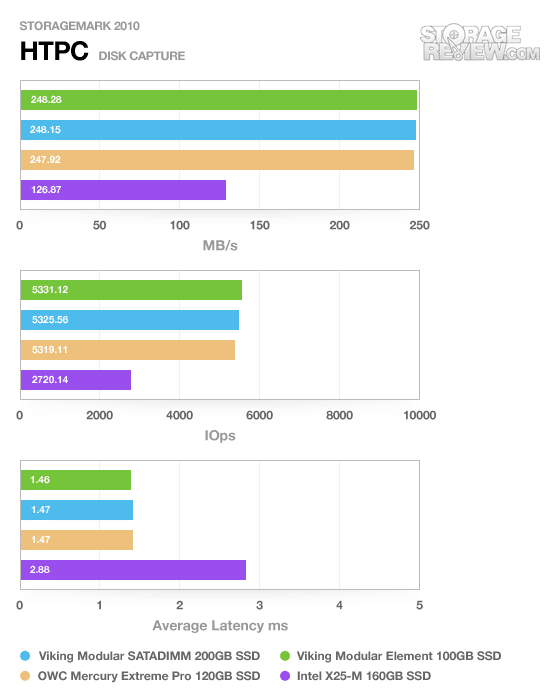
Once again, the SATADIMM cuddles up to the OWC drive, even slightly beating it. This test stresses writes fairly well, and the SATADIMM’s measured peak latency doesn’t manifest here.
The second trace is the “Productivity” test, which consists of: a three hour period operating with 32-bit Vista running Outlook 2007 and connected to an Exchange server, browsing the internet with both Google Chrome and Internet Explorer 8, editing files in Office 2007, viewing PDFs in Adobe Reader, an hour of local music playback, and then two additional hours of streaming online music from Pandora. Again, this is another situation that the SATADIMM could see itself in, populating a RAM slot in a small form factor, low-power terminal.
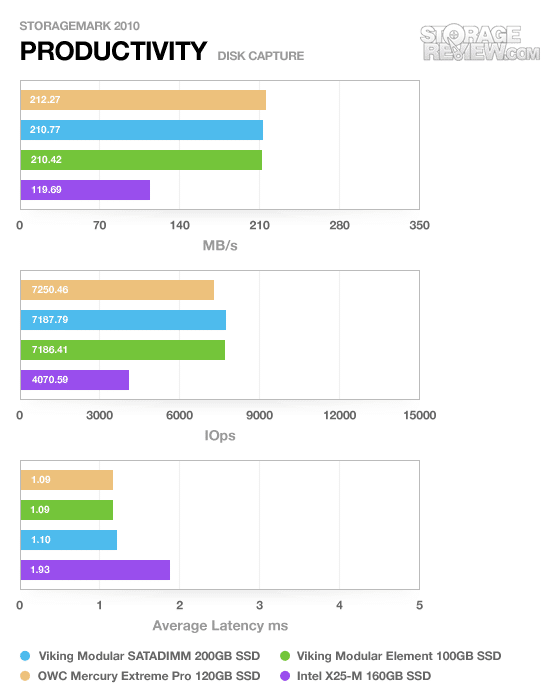
In this test, the OWC drive takes an ever so slight lead on the SATADIMM, but the numbers are still close enough for the difference to be largely academic.
The third and final trace is the “Gaming” test; this test is almost entirely read-based, and consists of Windows 7 Ultimate 64-bit configured with Steam, and traces performance loading and running Grand Theft Auto 4, Left 4 Dead 2, and Mass Effect 2.
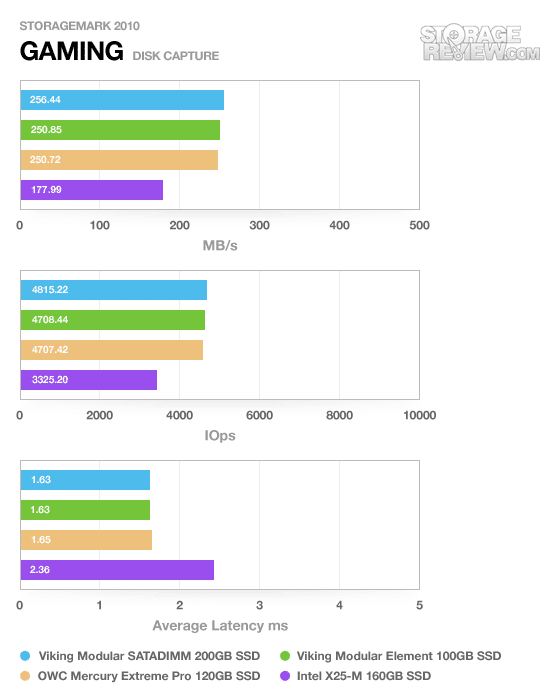
This is a situation where any potential weaknesses in write latency are easy to ignore; the gaming test is bound by reads, and here the SATADIMM produces a respectable lead over the other SandForce drives.
Power Consumption
Unfortunately, as a result of the SATADIMM’s unique form factor, we weren’t able to test its power consumption. Suffice to say, if it can survive just drawing juice from a DDR3 slot and still provide performance comparable to standard form factor SandForce SSDs, it’s probably fairly negligible.
Conclusion
Admittedly reading about the SandForce flavor of the week can get a little dry, but the Viking Modular SATADIMM brings something else to the table. Simply put, the SATADIMM is a lot smaller than a conventional drive, and its form factor and unique mounting mechanism – being able to sit in a DDR3 slot and survive off of 1.5 volts – are what make this a most interesting product.
Where it gets compelling is that the change in form factor is the only appreciable difference between the SATADIMM and Viking Modular’s other SandForce SF-15drive. The OWC Mercury Extreme Pro we tested it against is our go-to SandForce drive, largely best of breed, and the SATADIMM was able to perform nearly identically. The differences in pure numbers are largely academic. In fact, Viking Modular’s spec sheet largely understates the performance of the SATADIMM, enough that we had to doublecheck to make sure it was using a SandForce controller.
So again, that leaves us with a SandForce drive in what amounts to a unique form factor. In the enterprise, where physical space can be at a real premium, something like the Viking’s SATADIMM can make a heck of a lot of sense.
Pros
- Performs as well as the best SandForce drives we’ve seen
- Compelling form factor for enterprise audiences
- Operates off of just 1.5v from a DDR3 DIMM slot
- Plenty of capacity and NAND combinations to satisfy the market
Cons
- Limited availability – reserved for the enterprise market, not enthusiasts
Bottom Line
If you’re hurting for space or looking for a way to boost fast storage in an enterprise environment without having extra drives taking up space, the SATADIMM gets the job done with both style and speed.




 Amazon
Amazon